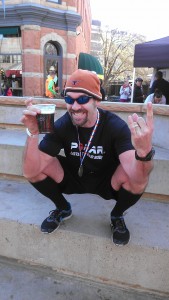I’ve had some on and off right shoulder pain for a while. Along with it has been some wrist and elbow pain. I’ve worked wrist mobility, elbow mobility and I’ve worked shoulder internal rotation as well as elevation and retraction of the scapula. Like I said, the pain comes and goes so I figure I’ve been knocking on the door of the issue, but I haven’t yet nailed it. I’ve employed the following process to very good effect. I’ve used the same process with several clients and seen some very nice changes in shoulder pain and mobility, and neck pain and mobility.
An elevated shoulder
Recently, I asked my wife to look at my shoulders from the back and see if there were any discrepancies or anything that seemed out of place. She quickly said my right shoulder was higher than my left. I took a wild guess and figured I had an elevated scapula and that perhaps my lower fibers of my trapezius muscle weren’t doing their job.
The trapezius
The trapezius (or “trap”) is an interesting muscle. As the name implies, it is a trapezoid. From the picture you
can see the superior fibers originate from the base of the skull and attaches at the lateral clavicle, acromion process, and the spine of the scapula. The middle fibers originate from C7 and T1-3 and attach at the acromion and scapular spine. The inferior fibers originate from T4-T12 and run upwards to attach to the lower scapular spine.
The traps do several things. Largely, they shrug your shoulders up (elevation), shrug them back (retraction) or shrug them down (depression). The traps also play a role in rotation, lateral flexion, and extension of the neck. The traps work closely with lots of other muscles including the lats, the levator scapula, deltoids, rhomboids, the muscles of the rotator cuff and a host of neck muscles. Consequently, if some part of the traps are too tight, too long or offline in some way, the result may be shoulder pain, neck pain or other issues down the line such as elbow, wrist or possibly jaw pain.
Mobilize & strengthen
To get things feeling and moving correctly, I like to start with soft tissue work via a lacrosse ball, the Stick, a foam roller, or whatever tool you like to use to soften tight tissue. I’ve found the stick rolled along the upper trap to be quite effective. An example is below. Also, I like to pin a lacrosse ball against my shoulder blade and the wall to get at the external rotators, mid traps, rhomboids, etc. I like to use the lacrosse ball in a similar fashion to work the pecs, but facing the wall instead of backing into the wall. Then, I’ve been using the following combination of stretches and strength work to put things in working order.
First are a couple of stretches I stole from Kelly Starrett at MobilityWOD.com. Both are useful ways to work on internal rotation and tie in some neck mobility. We often see poor shoulder movement that includes poor internal rotation and tight neck muscles–whether the lower trap is messed up or not. Working some internal rotation, moving the neck and loosening the tissue in that neighborhood seems to help facilitate good shoulder movement.
Second, I use the prone-Y simply to get a feel for what it feels like to use the lower traps. It’s nearly impossible to do this one wrong. Make sure to keep the glutes engaged so the low back doesn’t arch too much. Put a cushion under the forehead so as not to mash your face into the ground, bench, or table. I like to go to mild exertion. This isn’t something to make you grimace. It’s simply to get you connected to your lower traps.
The face-pull comes next. Take a staggered stance so as not to lean back. Keep the upper arms parallel to the ground. Keep the shoulders down–but don’t let the elbows drop. This may be a challenging skill for some. You may find your brain gets a tougher workout than any of the muscles involved. Again, no need to go to use a lot of weight or go to high exertion. Technique is #1 here!
Then I go to something I call a shrug-down. You can do this with a lat pull-down or cables or tubing of any sort positioned overhead. It can also be done with an assisted pull-up machine or unassisted hanging from a bar. The important thing is not to go too heavy. Just like the other exercises, this should feel too easy to start with. Many people find it quite difficult to shrug the shoulders down without bending the elbows. This is a skill and it may take some time, some steam coming out of your ears, and sticking out your tongue to master it.
Finally, I like going to a full cable pull-down or pull-/chin-up. Just like the other exercises, I suggest you go light. Try to separate the scapular depression (the shrug down) from the elbow flexion. See if you can make it sort of a two-part exercise: shrug down, pull up, lower yourself back down, un-shrug. Let me know if this helps your shoulder and/or neck issues.


